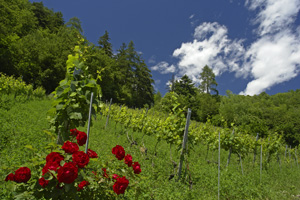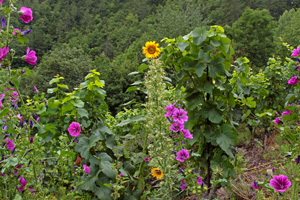Charter for Biodiversity in Vineyards
by Hans-Peter Schmidt
The main objective for the encouragement of biodiversity is to convert the vineyards into stable ecological systems and to increase the quality of the Terroir by means of a sustainable use of the natural forces.
1. The encouragement of biodiversity in the vineyard starts from the reactivation of the soils. For this purpose only bioactive manure is applied: compost, compost extracts, herb extracts, green fertilizer, red leaves capet, MRF. The uses of artificial manure, concentrated fertilizer, herbicides or liquid fertilizer are not allowed. An application of non-composted animal manure must equally be avoided.

2. Installation of a constant green manure through leguminous plants between the stocks. Recreation of a closed material flow and guaranteeing a nutritive supply of the stocks without the need of an additional artificial manure. The sowing of grand variety of leguminous plants provides a very high biological activity of the soil and improves the storage of water and nutrients as well as controlling the erosion.
3. Green soil cover all year round. The goal is to achieve a plantation rich in species with autochthonous flowers. At least 20% of the seeds mixture for the green manure must be composed of plants with flowers that attract insects. In total one must be able to find at least 50 types of wild plants on the vineyard.
4. Plantation of bushes at the end of the respective rows where they do not interfere with the work cycles. The criteria for choosing the bushes is based on the potential attractiveness to butterflies and other insects, the nesting possibilities, the symbiosis of the roots and the use of their fruits. Autochthonous species will be planted.
5. Plantation of hedges as an intermediate line between the stocks. Depending on the local conditions, at least 2 x 20m of closed hedges per hectare. The hedges are potent biodiversity hotspots and as aisles, ideal for a network connection of ecological areas. As natural barriers between the rows they hold back the epidemic spreading of harmful fungus.
6. Plantation of fruit trees for the improvement of the vertical diversity. Trees among plants of little height and in badly structured cultivation areas represent an enormous attraction for birds, insects and other groups of animals and encourage a repopulation of the ecological habitat. The trees that are outstanding in an aerial plankton also act as collectors of spores; an area from where the yeasts and other fungus can expand in the vineyard (diversity of natural yeasts for the wine making and as a competition for harmful fungus). At least one tree should be planted between the stocks for each hectare of ground as well as several small trees on the appropriate boundaries with orientation NE-NW. The distance to the nearest tree should not be more than 50m from any point of the vineyard. Possible losses in the Harvest may be compensated by the harvest of fruits.

7. Ecological compensation areas rich in species of at least 2 x 20 m2 for every hectare should be created as diversity hotspots both in the centre of the boundaries of the plots with stocks, where aromatic herbs and wild flowers grow (ruderal vegetation and flora, megaforbics). The distance to the nearest hotspot should not be more than 50m from any point of the vineyard.
8. Wild bees. Bees play an important role in the preservation of the vegetal diversity thanks to their pollinating activity. They also provide the vineyard with a very much appreciated secondary product. Thanks to the presence of insects and flowering plants until autumn there is no danger of damages caused by the bees on the grapes. The ideal is to have up to eight beehives per hectare. The pesticides used in the spraying must be composed by, therefore, harmless substances for bees and insects (renounce to chemical pesticides and sulphur)
9. Creation of structural elements such as stones and piles of woods for reptiles and insects. Installation of artificial nests for wild bees, insects and birds. The artificial nests may be integrated on the staking posts. Perches for birds of pray for a reduction of rodents.
10. Instead of grubbing the old vineyards and planting the surface again from scratch, the old stocks are replaced one for the other, choosing the plants by means of massale selection in the same vineyard and planting them as graft in the corresponding nurseries, therefore achieving a selection of varieties of multiple generations which adapts perfectly to the Terroir. The genetic diversity obtained, reduces the pressure of infection due to plagues, increases the hardiness before the dominant environmental conditions and improves the quality of the wine.


Martina Stöckmann
2009-09-06 12:17
Hallo,
ich habe eine große Wiese angrenzend an mein Hausgrundstück gekauft. Diese Wiese ist fast Tod, für mich jedenfalls, Pflanzenvielfalt Fehlanzeige, ich würde dort gerne Insektenpflanzen aussäen und da es sich um ~ 1000 qm handelt komme ich mit den im Einzelhandel üblichen kleinen Sämereitütchen nicht so weit. Es wäre supertoll über Euch an eine Händleradresse zu gelangen um dort mehr Menge in Bioqualität zu ordern, damit meine Obstbäume demnächst von lebendiger Wiese umgeben sind.
Ich weiß ich bin faul, denn mit ein bißchen Zeit findet sich so eine Adresse bestimmt über Google, etc., aber vielleicht habt Ihr ja eine Mailadresse direkt zur Hand und dann weiß ich das ist wirklich eine gute Adresse.
Vielen Dank im Voraus, mit lieben Grüssen aus dem Lipperland
Eure Martina Stöckmann
Ps.: Die Weinbergpfirsichkerne werden in den nächsten Tagen auch auf die Reise gehen, Danke auch da für die Adresse.
Ute Scott
2009-09-06 14:46
Hallo Martina,
ich würde an Ihrer Stelle erst mal herausfinden, warum die Wiese so artenarm ist.
Nicht jede Mischung Wildsamen ist für überall geeignet.
Und dann würde ich auch erst mal die Wiese ein/zwei Jahre so lassen (ein- oder zweimal mähen) und dann herausfinden, was ganz von alleine sich dort einfindet.
Und wie wäre es mit Bienen, die Ihre Obstbäume bestäuben, und wenn nicht Honigbienen dann durch Anbringung von Wilbienenhotels für kostenlose Bestäuber sorgen ?
Aus Erfahrung klüger
Ute Scott
Franzi Katharina
2009-09-30 06:18
Guten Tag
Wir haben einen winzigen Rebberg von 220 Reben, mitten in genutzten Wiesen, zwischen den Reben Gras, das regelmässig gemäht wird und um die Reben herum lassen wir eine Scheibe frei, die wir stets jäten (damit angeblich die Wurzeln tiefer reichen). Ja, ich weiss, ein armseliger Rebberg. Haben Sie uns einen Tipp, wie wir den Rebberg Schritt für Schritt verbessern können?
Danke im Voraus und herzliche Grüsse
Katharina Franzi
cln
2009-09-30 10:34
Liebe Frau Franzi
Ein erster Schritt wäre, zwischen den Reben die Grasnarbe oberflächlich umzugraben und anfangs Frühling eine Leguminosenmischung mit Luzerne, Esparsette und verschiedenen Klee-Arten einzusähen. Diese Gründüngung zur Bodenregeneration kann einfach mit dem Balken- oder Fadenmäher bei Bedarf gemäht werden. Das Schnittgut lässt man zur Humusbildung liegen. Unter den Reben bieten sich niedrigwüchsige Kräuter als Bewuchs an; Reben tendieren eher in kahlen, überdüngten Rebbergen dazu, oberflächlich zu wurzeln, da die Nährstoffe sich in den obersten Bodenschichten konzentrieren können und zudem keine Konkurrenz herscht. Da Reben sehr tiefe Wurzeln bilden können und gesunde Pflanzen dies auch tun, treten flachwurzlige Kräuter unter den Reben nicht in direkte Konkurrenz. In sehr trockenen Gebieten sollte darauf geachtet werden, dass sich unter den Reben nicht eine geschlossene Krautdecke bildet, da sonst weniger Wasser in den Boden eindringen kann. Bei Bedarf wird der Unterwuchs durch extensives Jäten aufgelockert (bei einer kleinen Rebfläche hält sich der Aufwand in Grenzen).
Für weitere Aufwertungen und Gedankenanstösse orientieren Sie sich am besten an unserer Charta und diversen Artikeln:
http://www.ithaka-journal.net/baume-inmitten-der-reblandschaft
http://www.ithaka-journal.net/nisthilfen-fur-wildbienen-im-weinberg
http://www.ithaka-journal.net/weinberge-als-lebensraume-fur-reptilien
http://www.ithaka-journal.net/mischkulturen-%E2%80%93-ein-weltweites-erfolgsrezept
Mit freundlichen Grüssen, Claudio Niggli
Hubert Pomplun
2009-10-18 10:04
Solche schlagwortartigen Zusammenfassungen am Ende ausführlicherer Darstellungen halte ich für sehr gut. Machen Sie weiter so! Wir sind Laien, die sich aus ökologischer Überzeugung schon lange mit dem biologischen Gärtnern beschäftigen. Ihre Arbeiten und die Berrichte darüber, die ja nun weit über die Werbung für "Bio-Wein" hinausgehen, sind Hilfe und Bestätigung.
sven ahlborn
2009-10-29 07:17
guten morgen,
gibt's die charta auch in f/i/e oder spanisch? ich würde diese gerne meinen weinproduzenten weiterleiten bzw. empfehlen.
herzlichen dank und weiterhin viel erfolg,
sven
hps
2009-12-20 16:42
Ja, die Charta exisitiert bisher auf Deutsch, Französisch, Englisch, Italienisch und Spanisch. Sie kann beim Delinat-Institut als Druckausgabe bestellt werden oder auf der Webseite: www.delinat-institut.org heruntergeladen werden.